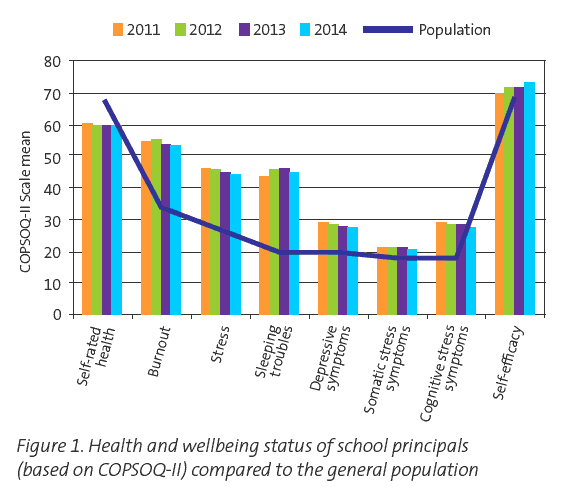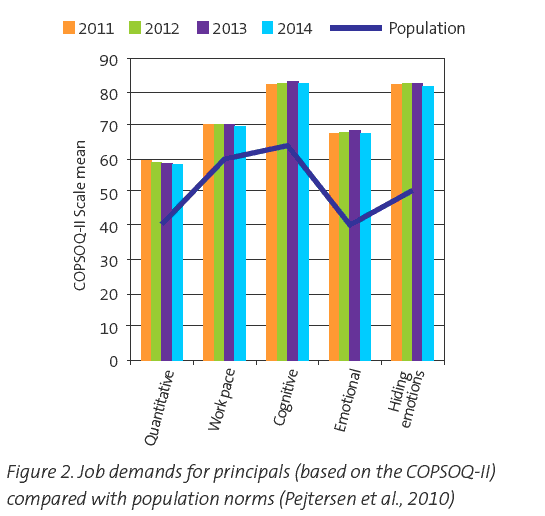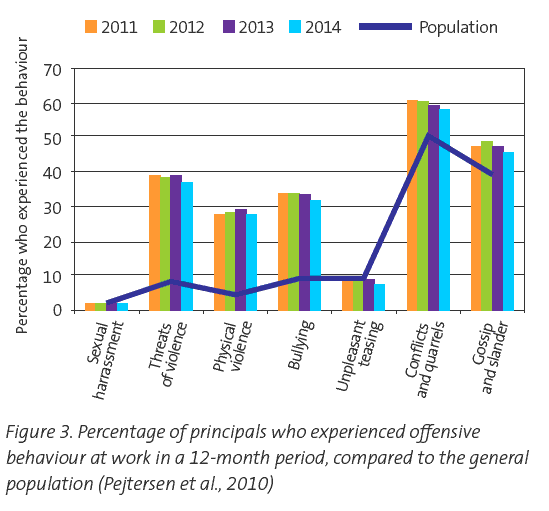The role of school principal in many parts of the ‘first world’ is rapidly changing. This has increased the stress levels of an already highly stressed occupational group. In the UK, where schools have been increasingly accountable for results via the publication of league tables, Phillips and Sen (2011) reported that, “work related stress was higher in education than across all other industries… with work-related mental ill-health… almost double the rate for all industry” (p. 177-8).
A significant stressor in the Australian context has been the increased emphasis by governments on accountability for uniform curriculum delivery along with the devolution of administrative tasks from central to local control. The work practices imposed by these changes further increase work volume and public accountability through external reporting deadlines. It is estimated that as approximately 70 per cent of Australia’s 10,000 school principals reach retirement age in the next five years, they will be replaced with much younger individuals whose inexperience creates potentially more risk of adverse health outcomes resulting from the stressors of the job.
The Australian Principal Health and Wellbeing Survey has been conducted annually since 2011 in response to this looming crisis. The confidential and independent survey, which collects annual information from principals working in all school sectors, assesses the impact of the increasing complexity and workload demands of school leadership roles on the health and wellbeing of Australian principals. Four years’ data from the annual survey is now available (N=3,675), providing important evidence and insights about the psychological risks at work for school principals.
Principals’ health and wellbeing
Among other measures, the survey uses the Copenhagen Psychosocial Questionnaire (COPSOQ-II; Pejtersen et al., 2010) to evaluate psychosocial factors at work and compare these to population norms The survey results indicate that principals have greater meaning attached to their work, higher commitment to the workplace, greater job satisfaction and feel their workplaces are more just and socially inclusive than the average workplace. However, principals’ levels of work-family conflict are much greater, indicating that work impacts significantly more on their family life than it does for employees in other workplaces.
The health and wellbeing status of school principals compared to population norms is presented in Figure 1.

Despite indicating high levels of many of the work variables contributing to good psychological health at work (meaning, satisfaction and good values), and experiencing factors associated with good health and wellbeing (relatively high salary and stable, secure employment), principals’ mean scores on health and wellbeing indices are considerably lower than the population norms. This is particularly true of the mental health measures, so it appears evident that aspects of the job are causing significant psychological health and wellbeing concerns.
Job Demands-Resources model of psychological risk
Stress and psychological risk at work can be conceptualised through the balance of job demands (e.g., workload, time pressures, physical environment, shift work) and job resources (e.g., feedback, rewards, control, job security, support). The Job Demands-Resources model (Demerouti et al., 2001) along with the Conservation of Resources theory (Hobfoll, 1989; Halbesleben, 2006) posit that work demands and available resources need to be in balance for good psychological health at work. In contrast, high job demands lead to exhaustion while low job resources lead to disengagement, both symptoms of job burnout.
A snapshot of principals’ job demands and resources provided through the Australian Principal Health and Wellbeing Survey, and presented below, shows that the Job Demands-Resources model of psychological risk is dangerously out of balance in schools, and can explain the concerning decrements in principals’ psychological health and wellbeing.
Work demands of principals
The job demands for school principals compared to population norms are presented in Figure 2.

The high levels of emotional demands for principals at work are notable. There is increasing recognition that high emotional demands and emotional labour significantly contribute to job strain (Newberry, Gallant, & Riley, 2013). This aspect of school leadership demands represents a significant psychosocial risk for principals.
The quantity of work and work pace are considerably higher demands for school principals compared with population norms. The survey also measures the hours at work for principals and shows that these school leaders are spending very long hours at work both during term time and in school holidays, citing workload as their greatest source of stress.
Another important survey finding indicative of stressful work demands is the high percentage of school principals who experience offensive behaviour at work compared to the general population (see Figure 3).

Principals experience threats of violence approximately five times higher than the general population and actual physical violence more than seven times higher. Bullying by parents, colleagues or subordinates is experienced at approximately four times the rate of the general population. This is more disturbing considering that some of these behaviours are likely to be occurring in front of school children.
Resources available to principals
Principals’ ratings of the importance of various sources of support are also surveyed. Partners provide the strongest support to principals, while the lowest scores are reserved for employers and departments of education. Although principals’ greatest source of support is their partners, other survey results outlined above indicate that principals’ work impacts significantly more on their family than it does for employees in other workplaces. Principals’ family needs are competing with work, making work‑life balance considerably difficult. Currently, work wins over family for principals at roughly twice the rate of the general population. This is concerning because as the source of greatest support, principals’ families buffer them against the strain of the job.
A small percentage of principals indicate receiving support from psychologists, and, while it is pleasing that psychologists are playing their part in supporting principals, it is likely that these are tertiary interventions at the individual level. More appropriate levels of organisational psychological support would clearly benefit the sector.
Although the survey collects data on principals’ health and wellbeing, it also has the capacity to act as an intervention. Principals who complete the survey receive interactive feedback on 43 separate dimensions of occupational health, safety and wellbeing through a dedicated secure website, affording instant health and wellbeing checkups tailored to their specific work context. The survey can thus provide detailed feedback and prompt principals to make changes to their behaviour. However, as the aggregated survey results show, much of the psychological harm is largely beyond individual principals’ control and needs to be addressed at the community and government level.
Conclusions
The education sector is one of Australia’s biggest employers. So, when disturbing evidence emerges about the occupational risks and poor psychological health and wellbeing of school principals across the country, this represents a significant national challenge. This challenge is made more salient when considering that school leaders’ employment conditions are students’ learning conditions.
The demands of principals’ jobs are seriously out of balance with the diminishing support resources available to them. Increasing bureaucracy and government accountability has significantly eroded principals’ decision latitude to deal with their work demands, further increasing the strain. Primary occupational health and safety interventions are needed to relieve principals from some of their job demands and increase their job resources. However, principals’ increased need for systemic support and resources to deal with the challenges is occurring alongside severe cuts to education budgets, and is potentially placing the future of our children’s education at risk.
The complete report on the Australian Principal Health and Wellbeing Survey for each year is available from the project website: www.principalhealth.org.
The author can be contacted at [email protected]